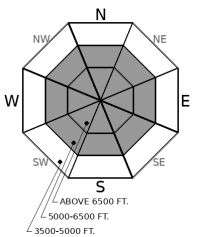| Tuesday | Tuesday Night | Wednesday | |
|---|---|---|---|
| Cloud Cover: | Overcast | Overcast | Overcast |
| Temperatures: | 30 to 35 deg. F. | 20 to 25 deg. F. | 25 to 30 deg. F. |
| Wind Direction: | Southwest | Southwest | Southwest |
| Wind Speed: | 15 to 25mph, Gusting to 40mph | 15 to 25mph, Gusting to 40mph | 10 to 20mph, Gusting to 30mph |
| Snowfall: | 5 to 9 in. | 4 to 8 in. | 1 to 3 in. |
| Snow Line: | 4500 ft | 4000 ft | 3500 ft |
Whitefish Range
Swan Range
Flathead Range and Glacier National Park
How to read the forecast
A storm will bring dense snow, rain, and wind through the day, creating dangerous avalanche conditions. As the storm ramps up, the danger will rise to CONSIDERABLE with human-triggered avalanches likely and natural avalanches possible. Avalanches in the surface snow may step down to a buried weak layer, resulting in a larger more dangerous slide. Cautious terrain choices and route-finding will be essential. The danger may rise to HIGH overnight.

3. Considerable
?
Above 6500 ft.
3. Considerable
?
5000-6500 ft.
2. Moderate
?
3500-5000 ft.
- 1. Low
- 2. Moderate
- 3. Considerable
- 4. High
- 5. Extreme
-
Type ?
-
Aspect/Elevation ?

-
Likelihood ?CertainVery LikelyLikelyPossible
 Unlikely
Unlikely -
Size ?HistoricVery LargeLargeSmall

Dense snow and wind will form slabs that increase in size and distribution as the day progresses. Thickest slabs will be found below ridgelines and in cross-loaded gullies. Slabs will form on a variety of surfaces that may inhibit bonding. Recent avalanches, cracking and whumphing are all signs of danger. This is a surface problem that can be identified by hand tests or ski/machine cuts on small test slopes. Wind sheltered lower angled terrain offers safer options.
-
Type ?
-
Aspect/Elevation ?

-
Likelihood ?CertainVery LikelyLikelyPossible
 Unlikely
Unlikely -
Size ?HistoricVery LargeLargeSmall

Our snowpack has a variety of weak layers found in the middle and near the bottom of the pack. These layers continue to be reactive in snowpit stability tests. Today's storm may overload these weak layers and cause failure. Avalanches on these layers may occur due to the weight of today's storm snow or from the weight of a surface avalanche stepping down. Either way, the end result is a larger, more dangerous avalanche. The only way to identify if a slope has a Persistent Slab is by digging into the snowpack. Today is a great day to seek out lower angle terrain in sheltered locations.
Combining dense snow and wind is a great recipe for slab formation. Slabs will form on a variety of surfaces including windboard, older slabs, melt-freeze crusts, and low-density snow. Moderate to strong winds will form slabs that are thickest and more widespread on leeward aspects. Recent stability tests have shown that buried weak layers continue to be reactive. A surface slide may step down to one of these layers and result in a larger more destructive avalanche. It is great to have precipitation return to our area, but today is a good day to temper our enthusiasm for fresh snow. After a long hiatus, we encourage fine-tuning avalanche skills on lower angle sheltered terrain. Be cognizant of overhead hazards and terrain traps while traveling today.
The storm will continue overnight with storm totals of over one inch of water and one foot of snow possible. If the forecast verifies, the avalanche danger may rise to HIGH overnight.
Fluctuating freezing levels will result in a mix of precipitation at lower elevations. Rain and wet snow will destabilize the surface snow throughout the day. Rollerballs and pinwheels will be the first signs of instability. Avoid traveling in or below long-running gullies or above terrain traps. If you find yourself sinking into mushy surface snow, or triggering pinwheels, you have overstayed your welcome on that slope.
Our next Avalanche Awareness talk is Thursday, December 20th at Penco Power Products at 6:30 p.m.!
We are offering an Avalanche Awareness talk Thursday, December 27 at Stumptown Snowboards at 7:00 p.m.!
We are offering a Motorized Level 1- Avalanche Fundamentals course January 11-13!
A warm, wet, windy system entered our area around 4:30 this morning. We expect fluctuating freezing levels with heavy wet snow at mid and upper elevations. The storm will continue overnight before tapering off tomorrow. Storm totals may exceed one inch of water/one foot of snow.
This forecast applies only to backcountry areas outside established ski area boundaries. The forecast describes general avalanche conditions and local variations always occur. This forecast expires at midnight on the posted day unless otherwise noted. The information in this forecast is provided by the USDA Forest Service who is solely responsible for its content.



























